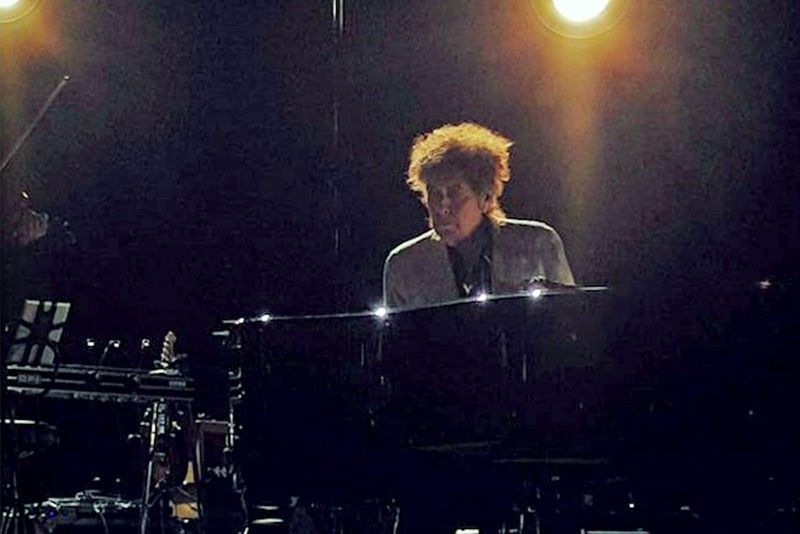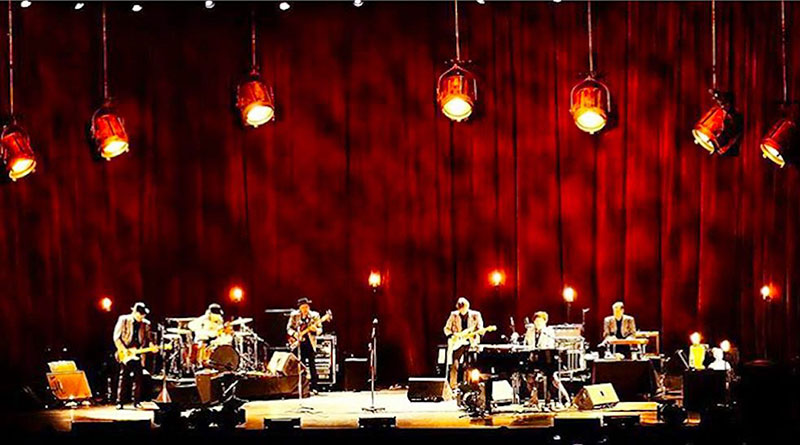Bob Dylan ain’t talkin’

First, there’s the familiar shape: the bushy hair, the framed silhouette taking the stage in near-darkness, clambering among musicians as he finds his way behind a baby grand. Black suit with maroon pants. You know it’s Dylan almost from the vibrations. There’s a palpable buzz before the show begins (promptly at 8:35 p.m.) at Star Theatre in Singapore. When his band (or rather, His Band) settle into the swamp-crawl blues opener Things Have Changed, you know you’re at a Bob Dylan concert.
Then there’s the familiar broken fog emanating from behind the keys. It’s not as weatherbeaten a voice as scribes have said, nor is it a busted croak, or a broken accordion bellows. It is Dylan’s voice, still the same somehow in many ways.
Bob Dylan is not a jukebox. When you see him live — as my wife Therese and I did last week — he does not play sing-along hits, though he does play songs you’ve heard from the past. It’s just that they’re recombined into unrecognizable shapes and forms. This is not Mamma Mia!, after all. This is Dylan. The Nobel-winning songwriter is 77, and that in itself is remarkable for somebody still touring and apparently still interested in performing live. The voice is still Dylan’s voice; it has not so much deteriorated as gathered layers of crust.
Still, watching Dylan live produces an ambivalent reaction in the listener. We are astounded at several moments, first by his actual human presence in the same room, then by the gradual realization that he will be dipping into his vast catalogue of songs, offering them up all night. No Sinatra covers in sight.
Not that it’s easy to figure out what song he is playing at any particular moment. Only by parsing the verses do we begin to decipher what he’s up to — a drifting It Ain’t Me, Babe or a radically revamped Tangled Up in Blue.
The power to transform songs is the prerogative of any artist. The man must get tired of playing Don’t Think Twice, It’s All Right for 50 years straight after all, so we must cut him some slack. You can’t really kill great songs anyway; you can only alter their appearances. They are like the Terminator in this respect.
In addition to four relatively obscure songs from his last album of originals, 2012’s “Tempest” (Soon After Midnight, the I’m A Man-ish Early Roman Kings, Duquesne Whistle and Pay in Blood), Dylan serves up a rewired Blowin’ in the Wind, a funky When I Paint My Masterpiece and lengthy journeys like Desolation Row, chords plucked out from behind his baby grand as though he’s tinkering beneath the hood of a ’57 Chevy.
“Is his piano out of tune?” my wife generously asks. No, it’s Bob who’s out of tune. His piano quirks at times conjure up Thelonious Monk hard bop stabs, at other times a wandering Bruce Hornsby, and at some moments a ‘50s TV crime drama.
Will somebody speak up for Bob’s piano playing? Eric Clapton will. In the tour program, he writes, “His way of playing anything is totally hybrid. When he plays piano, it doesn’t make any sense except to the listener, except to him… If you’re a musician, you’d say, well, what are you doing there? At first listening, everything he does is just real hopeless. Then you look back and realize, it’s exactly right.”

Dylan with touring band at the Hong Kong Convention and Exhibition Centre
His band is up for the mission, grafting a Duane Eddy/Peter Gunn riff onto Gotta Serve Somebody to great effect. There are many standouts, such as the joy of recognizing Simple Twist of Fate from “Blood on the Tracks,” and the honky-tonkish encore of Ballad of a Thin Man, sounding much as it did on “Before the Flood,” Dylan as ever hurling accusatory piano chords at an audience, it seems, still intent on dissecting him.
Yet we are somewhat put off by his refusal to leave that post behind the keys. Instead, he stands up, legs spread apart like Jerry Lee Lewis, pounding away at the ivories. A microphone stand at center stage goes ignored throughout the nearly two-hour show. Those expecting some strummin’ Dylan are disappointed, though there are shining moments when he pulls on his harmonica, and you realize that mouth organ can still say a lot of what his voice wants to say.
But the piano? It may be his chosen perch for the twilight years of The Never Ending Tour, but we could have done without so much vamping. Subtle shades would suffice.
Watching Dylan perform, one does not get the sense that he is interested in the audience’s reaction, one way or the other. Rather he seems content, on this night at Star Theatre, to plant himself behind his baby grand and utter not a single word to the audience, performing solely, it seems, for the members of His Band, whose actual identities remain anonymous and elusive. (Bob does not introduce them during any point of the show. For the record, it’s Charlie Sexton on lead guitar, Stu Kimball on rhythm guitar, Donnie Herron on pedal steel. mandolin and violin, Tony Garnier on bass and George Receli on drums.)
This, plus the extra strict policy of Star Theatre against any photographs, makes it, as Therese points out, a distinctly distancing experience. I mean, he could have said “Hello, Singapore” at least once. Or cheekily played, as my wife noted, On a Little Street in Singapore from his recent album of standards “Fallen Angels.” Not tonight.
Fortunately, His Band are a good band, capable of playing rock and swing and gospel and country and Delta blues with an almost supernatural level of empathy with their leader, whose often alien emanations on piano seem at cross-purposes to whatever they are jamming on. Let’s just say: Liberace, he ain’t.
The tracks from his 1997 comeback album, “Time Out Of Mind,” survive perhaps the best because they are barely altered, and the band are good at conjuring up a suitable swampy blues vibe. So we hear Love Sick, Trying to Get to Heaven, and To Make You Feel My Love in a more vulnerable light.
So we ought to be content that Mr. Dylan is not relying on other people’s standards but instead chooses to gift this audience with a treasure trove of hits, however carefully disguised. Yet this gift feels like a trick; with all due respect to Loki and Tom Hiddleston, Dylan remains the ultimate Trickster. Throughout his career he has constantly baffled people’s expectations (the man recently released his own whiskey brand called Heaven’s Door, for God’s sake), and this tendency shows no signs of slowing down, even into his late 70s. It was in some ways both the most generous and most stingy performance I’ve ever seen.
At the end of a two-song encore, Dylan finally leaves the piano stool and joins His Band at center stage. He doesn’t smile, nod or any of that. For a second, it’s as though he’s only just glommed onto the fact that we, the audience of fans, are actually out there, actually exist. The lights go down on the stage; Mr. Dylan turns and leaves.















